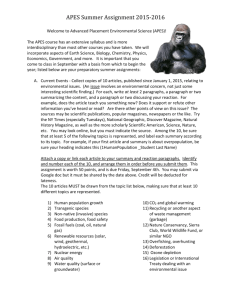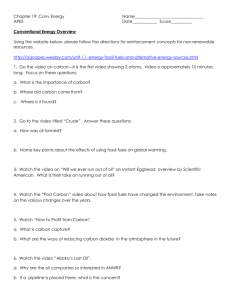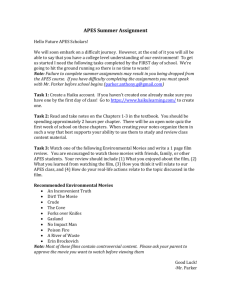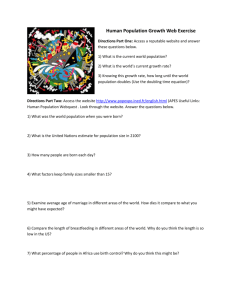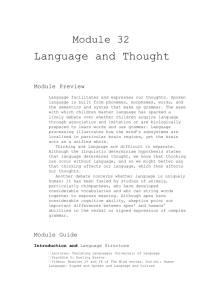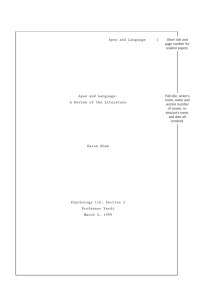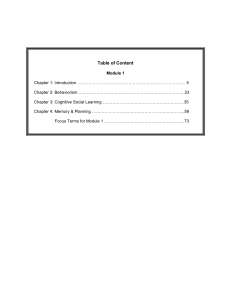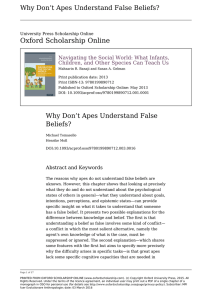EIM8e_Mod23 - Oakton Community College
advertisement
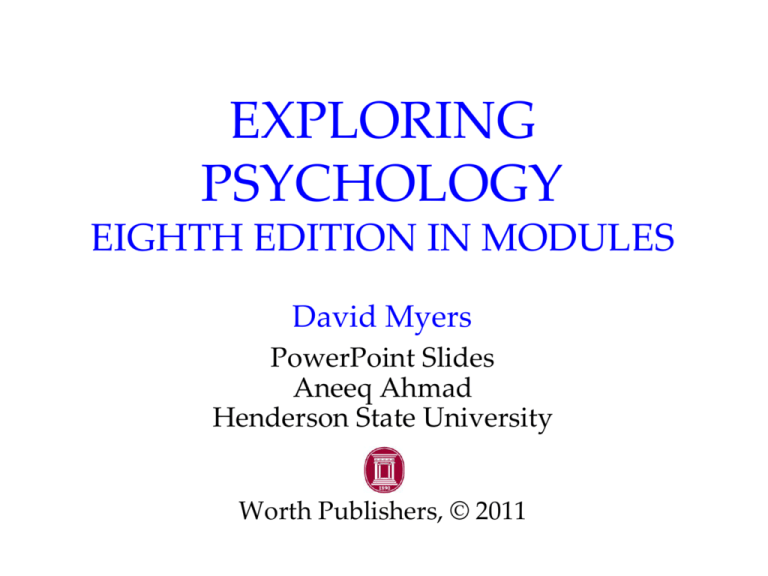
EXPLORING PSYCHOLOGY EIGHTH EDITION IN MODULES David Myers PowerPoint Slides Aneeq Ahmad Henderson State University Worth Publishers, © 2011 Thinking, Language, and Intelligence 2 Language and Thought Module 23 3 Language Development When Do We Learn Language? Explaining Language Development Thinking and Language Language Influences Thinking Thinking in Images 4 Animal Thinking and Language What Do Animals Think? Do Animals Exhibit Language? The Case of the Apes 5 Language and Thought Language, our spoken, written, or gestured work, is the way we communicate meaning to ourselves and others. Thanks to language, we transfer meaning from one mind to another. Language enables us not only to communicate but to transmit civilization’s accumulated knowledge across generations. 6 Language Development Children learn their native languages much before learning to add 2+2. We learn, on average (after age 1), 3,500 words a year, amassing 60,000 words by the time we graduate from high school. 7 When do we learn language? By 4 months of age infants can discriminate speech sounds and read lips. This marks the beginning of the development of receptive language, or the comprehension of speech. Also around 4 months, babies enter the babbling stage, spontaneously uttering various sounds, like ah-goo. Babbling is not imitation of adult speech. 8 When do we learn language? Productive language, the ability to produce words, matures after receptive language. Beginning at or around the first birthday, children enter the one-word stage, speaking one word at a time and able to make family members understand. The word doggy may mean look at the dog out there. 9 When do we learn language? Before the 2nd year, a child starts to speak in two-word sentences, the two-word stage. This form of speech is called telegraphic speech because the child speaks like a telegram: “Go car,” means I would like to go for a ride in the car. Once children move out of the two-word stage they quickly utter longer phrases and by elementary school can understand complex sentences and get the humor of double-meanings. 10 When do we learn language? 11 Explaining Language Development Operant Learning: Skinner (1957, 1985) believed that language development may be explained on the basis of learning principles such as association, imitation, and reinforcement. 12 Explaining Language Development Inborn Universal Grammar: Chomsky (1959, 1987) opposed Skinner’s ideas and suggested that the rate of language acquisition is so fast that it cannot be explained through learning principles, and thus most of it is inborn. 13 Explaining Language Development Childhood is a critical period for fully developing certain aspects of language. Children never exposed to any language (spoken or signed) by about age 7 gradually lose their ability to master any language. After the window for learning language closes, learning a second language seems more difficult. People who learn a second language as adults usually speak it with the accent of their first. 14 Thinking & Language Language and thinking intricately intertwine. Asking which comes first is one of psychology’s chicken - and - egg questions. 15 Language Influences Thinking Linguistic Determinism: Whorf (1956) suggested that language determines the way we think. For example, he noted that the Hopi people do not have the past tense for verbs. Therefore, the Hopi cannot think readily about the past. 16 Language Influences Thinking When a language provides words for objects or events, we can think about these objects more clearly and remember them. It is easier to think about two colors with two different names (A) than colors with the same name (B) (Özgen, 2004). 17 Language Influences Thinking To expand language is to expand the ability to think. Increasing word power pays its dividends. It helps explain the bilingual advantage of bilingual children to inhibit one language while using another. 18 Thinking in Images To a large extent thinking is language-based. When alone, we may talk to ourselves. However, we also think in images. Artists, composers, poets, mathematicians, athletes, and scientists think in images. 19 Images and Brain Imagining a physical activity activates the same brain regions as when actually performing the activity. Jean Duffy Decety, September 2003 20 Language and Thinking Traffic runs both ways between language and thinking. 21 Animal Thinking & Language What Do Animals Think? We are not the only creatures to display insight. Kohler demonstrated this with the chimpanzee Sultan. Some animals even display amazing numerical abilities. One researcher, Matsuzawa, has spent two decades studying chimps’ ability to remember and relate numbers. 22 Animal Culture Animals display customs and culture that are learned and transmitted over generations. Michael Nichols/ National Geographic Society Copyright Amanda K Coakes Dolphins using sponges as forging tools. Chimpanzee mother using and teaching a young how to use a stone hammer. 23 Do Animals Exhibit Language? There is no doubt that animals communicate. Copyright Baus/ Kreslowski Vervet monkeys, whales and even honey bees communicate with members of their species and other species. Rico (collie) has a 200-word vocabulary 24 The Case of Apes Gardner and Gardner (1969) used American Sign Language (ASL) to train Washoe, a chimp, who learned 181 signs by the age of 32. 25 But Can Apes Really Talk? 1. 2. 3. 4. Apes acquire their limited vocabularies with a great deal of difficulty, unlike children who develop vocabularies at amazing rates. Chimpanzees can make signs to receive a reward, just as a pigeon who pecks at the key receives a reward. However, pigeons have not learned a language. Chimpanzees use signs meaningfully but lack human syntax. Presented with ambiguous information, people tend to see what they want to see (perceptual set). 26 The Case of Apes Continued research with Washoe and her foster son, showed that chimps can think and communicate. Others have shown that pygmy chimpanzees can develop even greater vocabularies and perhaps semantic nuances in learning a language (Savage-Rumbaugh, 1993). Kanzi (shown below) developed vocabulary for hundreds of words and phrases. Most now agree that humans alone possess language, if we mean verbal or signed expression of complex grammar. If we simply mean an ability to communicate through a meaningful sequence of symbols, then apes are indeed capable of language. 27


